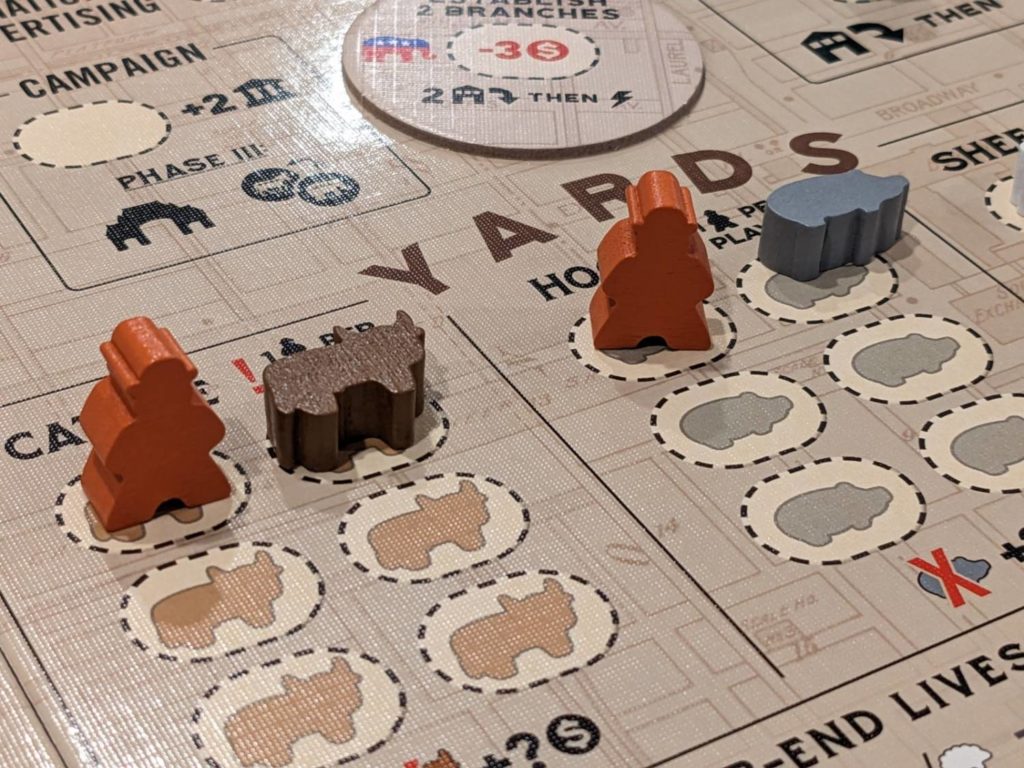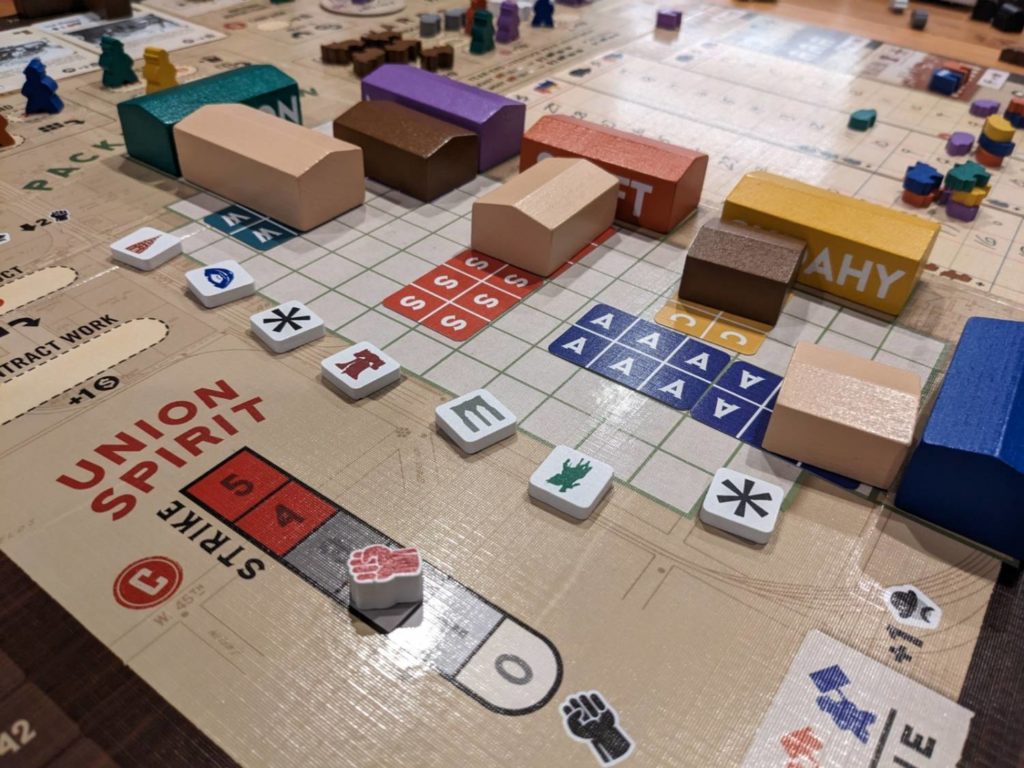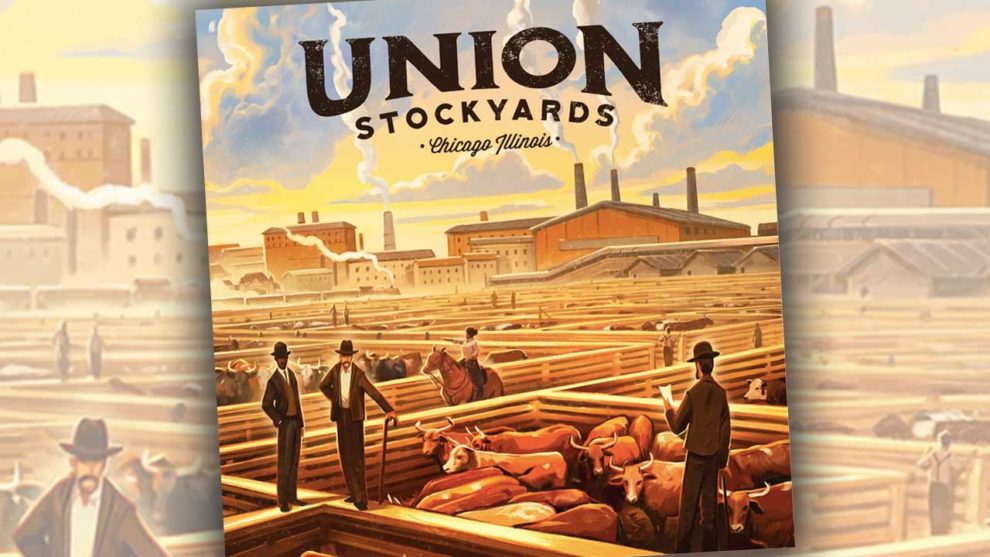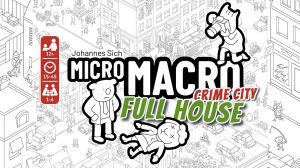Disclosure: Meeple Mountain received a free copy of this product in exchange for an honest, unbiased review. This review is not intended to be an endorsement.
I reached out to designer Duane Wulf on BGG recently because I was interested in his new game Union Stockyards, published by Solid Rock Games. I was intrigued—I always want to try games about Chicago, but I also lean in when all of the following things are present:
- Economic/market manipulation mechanics
- Steaks
- Worker placement
- Bacon
- Polyomino elements, as long as they are light
- A history lesson, ideally about meat
- A play time that is promised as short (90 minutes or less)
- The possibility of a worker strike
- Quality components
- Politics (again, as long as they are light)
- Hogs
Duane was kind enough to send a review copy…and on the day my copy arrived, I went to a game night where another guy in one of my gaming groups wanted to get his new copy of Union Stockyards to the table.
It all sounded like a match made in (hog) heaven.

Cattle Drive
Union Stockyards is a 2-5 player worker placement and market manipulation game set in the world of the Chicago stockyards era in the late 1800s and early 1900s. (I do enjoy games about Chicago in the late 1800s and early 1900s, by the way.) Players take on the role of slaughterhouse owners from the era such as Gustavus Swift (owner of the company now known as Swift & Sons) and Michael Cudahy (of Cudahy Packing Company).
The game’s snappy play time comes thanks to limited choices and maintenance phases that are super-quick. Starting with a selection of 3-4 workers, depending on player count, games of Union Stockyards take place over six rounds known as Years. After resolving an event card, which usually involves moving a Union Spirit marker up based on the current mood of the workforce, players take actions in turn order.
For gaming veterans, the great thing about Union Stockyards is that there’s nothing particularly novel about the available actions. You’ll slaughter an animal to make cash. You’ve got tracks, including the three main animal tracks, and a Brand Recognition track that can also trigger bonus moves on the animal tracks. You can spend money to place “Branch Houses” to earn end-game points, or buy land then later build buildings to score end-game victory points (and, yes, move up on more tracks!).
Buildings are presented in polyomino/Tetris format: take a wooden building from the supply matching the picture on a card, then place it extending from your initial slaughterhouse on the Packingtown area of the board to represent your growing enterprise. These buildings score end-game points, but also score points if built adjacent to a building matching in color.
When I first sat down at the table, it looked like Union Stockyards was going to be a big piece of chicken. (You’ll notice a theme here.) But the teach for my first five-player game was fast, and I was surprised how quickly everything made sense to me.
You’ve got a lot of the elements recognizable in a classic Eurogame design: public milestones (many of the buildings have a tag, and when one player gets 2-3 of those tags they take a Specialist card to score more end-game points), worker placement, four different tracks, and limited spots to score end-game points with the Branch Houses. Player order does not rotate automatically; a player has to choose to take the worker placement spot that gives them two points and first player rights for the following round.

“Wait, It’s Already Round Five?”
In each of my games of Union Stockyards, someone blurted this line out in completely transparent shock. The game is fast. I mean, really fast.
My first two-player game took about 45 minutes. The five-player game (with three players who had played once before, and two brand-new players) took 90 minutes including the teach. I did a three-player game in 55 minutes. For the amount of things going on, it’s hard to believe how fast things will go.
In part, that’s because of the Union Spirit area of the board. The track there goes from 0-5, with the marker starting at one when play begins. Each round, this track usually goes up 0-2 spaces; when it gets to space four or five, the union strikes and all players lose access to one of their workers. Each of my games has had at least one strike round, and in some games, the workers stayed on strike for multiple, consecutive turns.
Strikes mean that play is even faster, because in a five-player game, you are only taking two actions per turn. If no one chooses to take the action that gives them rights to becoming the first player in the next round, this is bad! If someone does choose to take the first player action (known as “Election”), then they can choose to flip the Election Token to make an action available that lowers the Union Spirit track by three, which essentially guarantees that there will not be a strike for the next round.
The other issue with strikes: Low Morale Tokens. Each of these Tokens costs a player points at the end of play, with this effect stacking in a pretty powerful way. If you have two of these Tokens, you’ll lose six points at the end of the game. Four Tokens? A negative 20 points!
You’ve also got tracks for beef, pork and lamb prices. During the game, players can slaughter an available animal for the difference between their meat value and the current livestock price; this is the main way to make money. But those tracks are always on the move, often as a result of player actions.
You’ve got to buy land, to save money on the cost of placing Building Cards. You’ve got to get buildings on the Packingtown map; it’s a great way to both advance on tracks and score end-game points. You’ve got to stay up on the Brand Recognition track, because the leader on that track will score a bunch of points plus get small but meaningful animal track bonuses during play.
It all seems like it should be a lot, but I’m surprised to see how many people have approached this game with initial fears then plowed through the available actions. There’s a lot of meat on the bone for such a short game; experiences like Galileo Project, Magnate: The First City, and The Taverns of Tiefenthal all serve as games where it feels like a lot gets done in a very short amount of time.

Where Does It Miss?
Union Stockyards did have a few issues.
The first is the board state in Packingtown. Over the course of an hour, it turns into a bit of an eyesore. The buildings are colored in various states of bland: beige, dark brown, plain white, and gray. You’ve got a lot of buildings sitting on a number of small cards, and everything shifts a bit during the course of the game. By the end of my five-player game, you couldn’t even see the names printed on the sides of each player’s starting slaughterhouse—it looks like a terrible office complex. And while that might have been the idea, it doesn’t look great in practice.
Two of my issues come with the gameplay. First, limited actions. In a higher player count game, you’ll have multiple rounds with only two actions. For such a short game to get even shorter, Union Stockyards can sometimes feel almost too short. Scores will be low (and lowered further by accumulated Low Morale Tokens), and you may feel like you didn’t have enough time to do anything meaningful. This goes away a bit at lower player counts, so my sense is that Union Stockyards plays best at 2-3 players, not 4-5. (The two-player game uses the back side of the board, and may have been my most enjoyable game.)
The second issue I had: the Buy Land action. Players must build connections from their starting slaughterhouse; your first building will touch that slaughterhouse. However, players can buy land and place a card representing land they own anywhere on the Packingtown map. That means that a player could use their first action of the game to buy land directly in front of your slaughterhouse. While you could build around this, you will likely have to pay that player to build your very first building on their land.
In one of my games, a player did just that. This action does give the game some teeth, but it will rub some players the wrong way. On the one hand, it’s a great way to make money, particularly later as players try to snatch up the land that will clearly be the best way for anyone to place buildings. On the other hand, this will probably annoy the heck out of your “friend” sitting nearby.

Hogwild
Union Stockyards is a solid entry in my growing “fast Euro” library.
It’s a joy to teach because it is so quick. The setup is not too varied (mainly in the form of the available building card market), but provides just enough of a change from play to play that there are always things to look forward to. I love worker placement games where everyone has tough choices; it’s rare that you’ll have two chances in a round to take the action you really want. The iconography in Union Stockyards is excellent; players rarely had questions about what a card means or what actions are conveyed without any words present.
The production here is fantastic. Solid insert (one that is actually too big for the items included in the base game, which definitely screams “expansion content inbound”), great rulebook with lots of examples, and a double-sided mat/player aid that can almost be used to teach the entire game. On the back of the player mats, a history of the company you will be playing provides a few fun facts. The event and Specialist (milestone) cards have a short but well detailed history lesson of various events, and the pictures here are something else. The manual also takes a page to explain the place of safety, women, and references in the design, with a back cover that serves as an appendix for what’s going on here.
Money is tight in Union Stockyards, but it’s not too tight. In one game, a player had $17 at one point and everyone at the table considered getting that player’s autograph. Normally, you might have $5 or $6 and feel like the wealthiest lamb slaughterhouse in America…then, on the next action, all of the money will be gone because you want to buy a building and get it out there before someone else can snatch the land you want.
The end-game state is messy (especially at higher player counts), but Union Stockyards does provide a healthy sense of accomplishment. The game’s two tiebreakers are aligned with the Brand Recognition track, a clear hint that this is an important piece of real estate. While I am sure players have won games of Union Stockyards by completely ignoring this track, the bonuses here are exceptional—bumps on all three meat tracks by advancing along its spaces, and potentially a nine-point bonus for a player who leads there (in games of 3+ players) at the end of the game.
I worry that this will limit the replayability of Union Stockyards; the four tracks are a good chunk of the final scoring. When players see a chance to go up on the beef or pork tracks by three or four levels, that can create an important gap both in the chance to slaughter an animal for a lot of cash, and for that end-game profit margin difference. Although my plays have been limited (I played this four times, once at each player count), I wonder where I would be with Union Stockyards after, say, my tenth play.
But we aren’t at that tenth play just yet. Union Stockyards is a great way to spend an hour with friends, and you’ll learn a thing or two about the process of how that bacon made it to the table of your great-great-grandparents. I’m curious to see if expansion content makes its way to the stockyards soon!











Add Comment